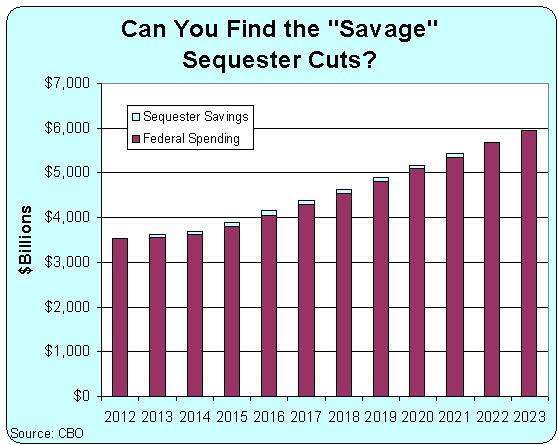So why is the sequester so bad? Does it slash the budget by 50 percent? Does it shut down departments, programs, and agencies?
Sounds good to me. We need to reduce the burden of government spending, so some genuine budget cuts would be very desirable.
The pro-spending lobbies in Washington certainly are acting as if spending would be “cut to the bone.” As documented by my colleague Tad DeHaven, they’re claiming horrible things will happen.
So what’s the real story? Well, the Congressional Budget Office today released its annual Budget and Economic Outlook, and Tables 1-1 and 1-5 allow us to see the “brutal” impact of the sequester.
As you can see from this chart, the sequester will “cut” spending so much that the budget will grow by “only” $2.4 trillion over the next 10 years.

Rather anticlimactic, I admit. No widows dying in snowbanks. No blood flowing in the streets.
So you can let the women and children back in the room. It turns out that all the hyperbole and hysteria about the sequester is based on the dishonest Washington definition of a budget cut—i.e., when spending doesn’t rise as fast as projected in some artificial baseline.
Yes, some parts of the budget are disproportionately impacted, such as defense. But even the defense budget climbs over the 10-year period and the United States will still account for close to 50 percent of global military outlays when the dust settles.
The bottom line is that there’s no reason to worry about the sequester and there’s certainly no reason to go along with Obama’s plan to replace the sequester with a tax-heavy budget deal.
Sounds good to me. We need to reduce the burden of government spending, so some genuine budget cuts would be very desirable.
The pro-spending lobbies in Washington certainly are acting as if spending would be “cut to the bone.” As documented by my colleague Tad DeHaven, they’re claiming horrible things will happen.
So what’s the real story? Well, the Congressional Budget Office today released its annual Budget and Economic Outlook, and Tables 1-1 and 1-5 allow us to see the “brutal” impact of the sequester.
As you can see from this chart, the sequester will “cut” spending so much that the budget will grow by “only” $2.4 trillion over the next 10 years.

Rather anticlimactic, I admit. No widows dying in snowbanks. No blood flowing in the streets.
So you can let the women and children back in the room. It turns out that all the hyperbole and hysteria about the sequester is based on the dishonest Washington definition of a budget cut—i.e., when spending doesn’t rise as fast as projected in some artificial baseline.
Yes, some parts of the budget are disproportionately impacted, such as defense. But even the defense budget climbs over the 10-year period and the United States will still account for close to 50 percent of global military outlays when the dust settles.
The bottom line is that there’s no reason to worry about the sequester and there’s certainly no reason to go along with Obama’s plan to replace the sequester with a tax-heavy budget deal.

No comments:
Post a Comment